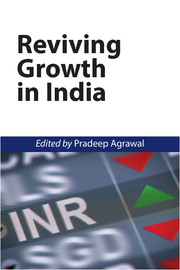Book contents
- Frontmatter
- Contents
- List of Tables and Figures
- Preface
- Section 1 The importance of growth
- Section 2 Reviving growth of industry and exports
- Section 3 The dampeners to growth: Controlling inflation
- Chapter 6 Macroeconomic Effects of Monetary Policy in India
- Chapter 7 Role of Monetary Policy in Sustaining High Growth in India: Lessons from the Recent Dynamics in Determination of Bank Credit
- Section 4 The supply constraints to growth
- Section 5 Emerging issues in growth: The labour and capital markets
- Contributors
- Index
Chapter 6 - Macroeconomic Effects of Monetary Policy in India
from Section 3 - The dampeners to growth: Controlling inflation
Published online by Cambridge University Press: 18 December 2015
- Frontmatter
- Contents
- List of Tables and Figures
- Preface
- Section 1 The importance of growth
- Section 2 Reviving growth of industry and exports
- Section 3 The dampeners to growth: Controlling inflation
- Chapter 6 Macroeconomic Effects of Monetary Policy in India
- Chapter 7 Role of Monetary Policy in Sustaining High Growth in India: Lessons from the Recent Dynamics in Determination of Bank Credit
- Section 4 The supply constraints to growth
- Section 5 Emerging issues in growth: The labour and capital markets
- Contributors
- Index
Summary
INTRODUCTION
Despite the structural differences between advanced and emerging market economies, cyclical fluctuations seem to have been more synchronized in the last decade, although it has been accompanied by pro-cyclical macroeconomic policies in the latter group of countries in the 1990s, partly due to the existence of large negative output gaps and structural inflation in these economies. In this chapter, we investigate the interaction of business cycles in India (as a key small open emerging market economy) and its macroeconomic policy, as understanding the macroeconomic dynamics has become important during the post-reform period. The mechanism by which monetary policy is transmitted to the real economy remains a crucial question to assess the relative importance of the interest rate or exchange rate channels in the context of India. The monetary authority in India adopts a multiple indicators approach to signal the central bank's assessment of the economy. Changes in the policy environment since the later half of the 1990s have brought in alternative monetary policy instruments in transmitting policy signals to the financial markets (see Bhattacharyya and Sensarma, 2008). Further, given the openness of the Indian economy, particularly since the mid-1990s, the monetary and financial system can no longer be immune to external shocks (Bhattacharya et al., 2008). This chapter, therefore, examines the monetary policy transmission mechanism over this post-reform period along with understanding the influence of the exchange rate as the central bank [Reserve Bank of India (RBI)] used to be a net-buyer of foreign exchange in the FX market (see Figure 6.1). Figure 6.1 clearly shows a regular net purchase of foreign exchange, while the net sale is resorted to only occasionally in times of crisis. This regular intervention explains why the real effective exchange rate remains stable while the nominal effective exchange (NEER) rate shows a depreciating trend (see Figure 6.2), in an attempt to boost export competitiveness. However, the accumulated inflation differential of India over its trading partners contributed to the recent collapse of the rupee in 2013.
- Type
- Chapter
- Information
- Reviving Growth in India , pp. 141 - 169Publisher: Cambridge University PressPrint publication year: 2015
- 1
- Cited by



